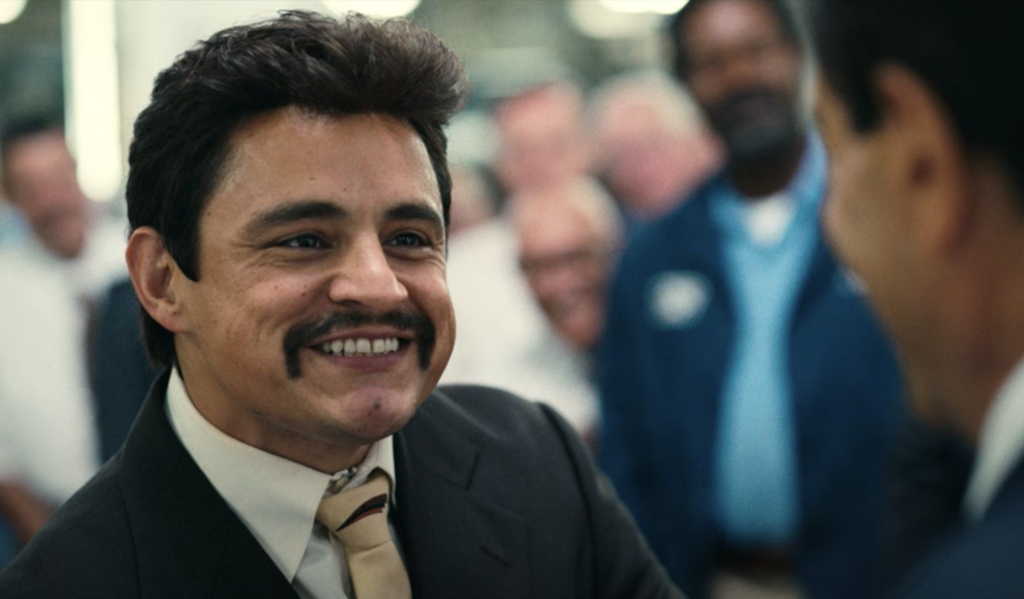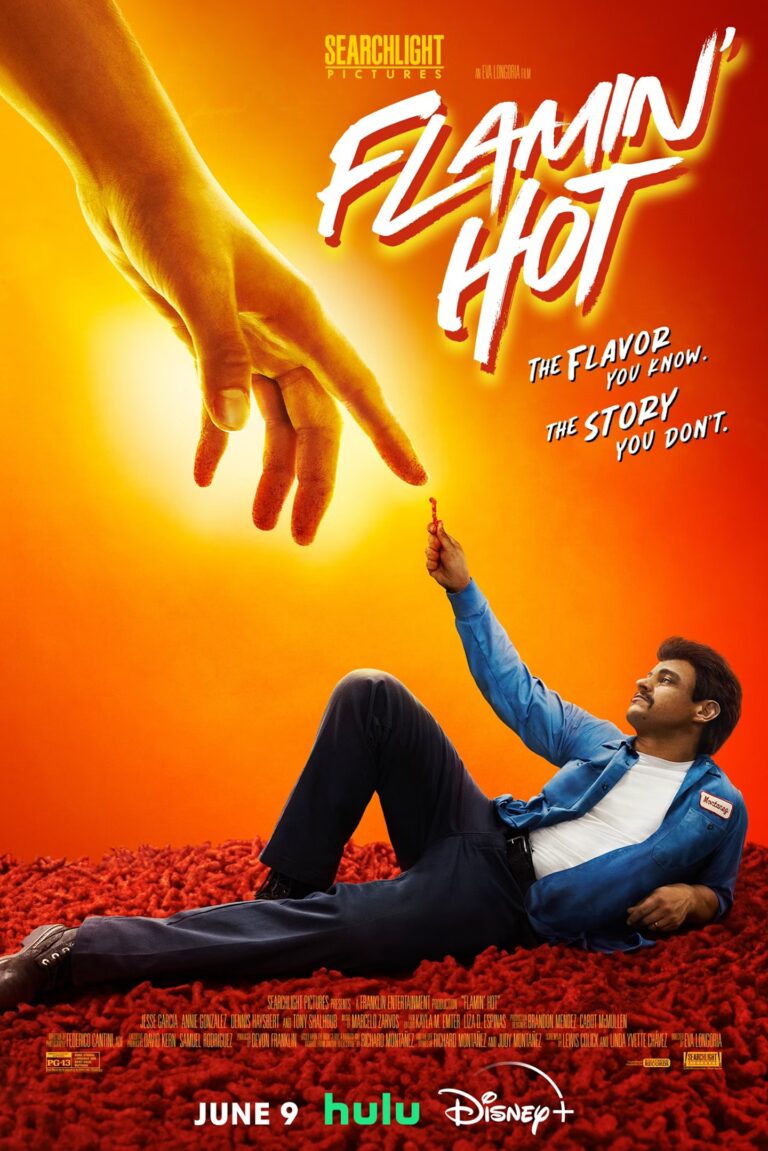Flamin Hot – Snapshot
Flamin Hot tells an emotional tale of a Mexican immigrant in Southern California who, as a janitor, invents Flamin’ Hot Cheetos for Frito Lay and rises quickly up the ranks to become an executive. The problem is the story isn’t entirely truthful and that diminishes both the movie and the people it is trying to portray. (1.5*)
Where to Watch:
Stream: Hulu/Disney+
Rent: (Nowhere)
(Note: Both my editors and Search Engine Optimization seem to hate apostrophes. Therefore, in this review I have eliminated the apostrophe in the movie’s title. My apologies to the filmmakers!)
Flamin Hot – The Oscar Buzz
Oscar Nominations (1) / Oscar Wins (0) :
Original Song (“The Fire Inside”, Diane Warren)
Diane Warren received her 16th nomination for “The Fire Inside” that she wrote for Flamin Hot. Despite being a powerhouse in the song-writing world, she has never won an Oscar. (I’ve listed her five most recent nominations in the next section, and I have reviews of four of them). Original Song, however, is not one of my favorite categories because frequently the song has no role in the movie itself, it only runs during the credits. Unfortunately, that happens in this movie too.
The only other Oscar connection I was able to find comes from the Sound department. Phillip Bladh won the Sound Oscar for Sound of Metal. Greg Orloff won the Sound Mixing Oscar for Ray and was nominated for Inside Llewyn Davis, True Grit, and No Country for Old Men. While good sound is always required to make a movie, I didn’t see any outstanding sound contributions in Flamin Hot.
Flamin Hot is Eva Longoria’s debut as a feature film director. She is, perhaps, most famous for her long-running role in TV’s Desperate Housewives. While Flamin Hot is not a great film, she shows her passion for her roots and could well grow into an interesting filmmaker if she keeps working at it.
Flamin Hot – Related Movies
Direct Ancestors:
(None)
Other Eva Longoria Films:
(None – this is her first feature film as Director)
Other Influences:
Marvelous Mrs. Maisel/Monk (TV)(Shalhoub)
Breakthrough (19) (Haysbert/Music/Song)
The Six Triple Eight (24)/Tell It Like a Woman (22)/Four Good Days (20)/The Life Ahead (20)/RBG (18) (Songs by Diane Warren)
May December (23) (Music)
Four Good Days (20) (Production Design)
Being the Ricardos (21) (Makeup)
Sound of Metal (19)/News of the World (20)/Killers of the Flower Moon (23)/The Irishman (19)/Inside Llewyn Davis (13)/True Grit (10)/No Country for Old Men (07)/Ray (04) (Sound)
As Eva Longoria’s directorial debut, Flamin Hot does not have any other directly related films – she hasn’t had enough experience to figure out her filmmaking style. Viewers might recognize the actor playing Enrico (Tony Shalhoub) from his TV performances as Monk and as the father in The Marvelous Mrs. Maisel. The other movie I’ve seen with the most cast and crew overlap with this one would have to be Breakthrough. There are similarities in that the films are both feel-good movies and they emphasize faith.
Flamin Hot – What Others Think
Professional critics weren’t too enthusiastic about Flamin Hot, rating this film just third from the bottom, above only Napoleon and Golda! Brian Tallerico (RogerEbert) called it “Depressingly unambitious, too content to skim the surface of its characters and a story in a manipulative and even dishonest manner.” And later “filled with hand-holding and simple cultural lessons.” Monica Castillo (also RogerEbert) criticized the writers who “can’t find a balance between the relatable human drama and low-brow jokes…or cliched moments…”. Adrian Rivera (New York Times) said Flamin Hot is “not only a bad movie. It is a poor piece of propaganda.” Ouch!
General audiences were a bit more sympathetic with comments like “cute watch”, “simple underdog story” and “Did PepsiCo get this Ad for Free”. Although not a whole lot of people seem to have seen it, viewer ratings put this just about in the middle of the 2024 Oscar list. So, Not Bad, but Not Real Good either!
Overall Flamin Hot ends up rating towards the bottom of this year’s films, tied with El Conde, Maestro, and Indiana Jones and the Dial of Destiny.
Flamin Hot – Special Mention
The “True Story” – is what Flamin Hot purports to tell – they say it on screen – and, of course, that means it must be. Supposedly it is the accurate recounting of how the Frito-Lay division of PepsiCo developed and began selling the “Flamin Hot” flavor of their popular products Fritos, Doritos, and Cheetos! It makes for a remarkable story about how a Mexican in Cucamonga manages to convince the CEO, Roger Enrico, to infuse their existing products with a particularly poignant and very Mexican flavor. The critical idea is not just a new flavor, but the notion that an entire market, the Mexican, and other Latin-American, communities are not being recognized by a major company. The movie is based on a book, the memoirs of the lead character Richard Montanez, called “A Boy, A Burrito and a Cookie: From Janitor to Executive” (which I haven’t read). The script, from Lewis Colick and Linda Yvette Chavez, apparently is a good adaptation of what is written in the book, which was published in 2014.
But there is a problem! In 2021 the Los Angeles Times did their own investigation of Montanez’s book and found that it didn’t quite jive with known facts in some important areas. The biggest non-truth is the idea that janitor Montanez called the Frito-Lay CEO, and, more or less sold him on the idea for a Hot and Spicy Cheeto. The contradiction is that Enrico did not become chief executive of the company until six months after the spicy snacks were being test marketed in several mid-western cities. The spicy ingredients were developed in a laboratory, as the movie makes a fleeting reference to, in Plano, Texas, not in Montanez’s home in Cucamonga, California. And a junior employee, named Lynne Greenfield, working in Texas, came up with the name. While it is true that Montanez started as a janitor, he was promoted to machine operator during his first year – he did not remain a janitor for ten years, as the film suggests.
There are some truths in the film. Montanez did rise through the ranks at Frito-Lay to become an executive focusing on marketing to Hispanic consumers. And while he had little to do with the development of the Flamin’ Hot Cheeto, he was instrumental in using the same spicy mix to flavor popcorn and marketing it to the Hispanic community in Southern California. But that didn’t happen until a full two years after the original hot Cheetos were already a solid hit.
The film, in the epilogue where the real Montanez and his wife appear, says this is a “true story”. And Montanez insists that he didn’t know what was going on outside of his local plant and so was unaware of developments in the Midwest. But he also insists that the movie is, at least, substantially true. Eva Longoria, the director, supports her subject and says that the film tells “Montanez’s truth”.
Flamin Hot – Michael’s Moments
I suppose it could be argued that the “real” truth, doesn’t matter if the movie is emotionally resonant. And Flamin Hot does jerk the tears at times. But once I learned that I was being told a highly fictionalized account, my attitude towards the film changed abruptly. We were, frankly, being emotionally manipulated, and that truth sort of drained me of whatever enthusiasm I might have had. The movie is “selling” to us the same way Frito-Lay was selling to the Hispanic community.
But you have to add to the falsehood problem, the negative picture of Hispanics that the movie paints. I realize that the intent of Longoria and the filmmakers is just the opposite. But while we are supposed to be engaged by Montanez’s initiative and determination, we are also being painted with a disturbing picture of a “white” society, controlling all the levers of power, and doing so with a very clear message that people with Brown skin aren’t really worth as much. While the current occupant of the White House doesn’t exactly bolster my argument, I’d like to suggest that not all white folks are as racist and stupid as the movie suggests. Nuance is what makes for a good motion picture – things are never, or at least weren’t until very recently, as clearly black and white (or brown and white) as Flamin Hot suggests. The movie implies, incorrectly I think, that American society is simpler than it really is.
In the end, Flamin Hot is just not a very good film. It has all the tear-jerking effects of a Hallmark Christmas movie, and paints a simplified picture of race and ethnicity in America. Just why would you want to see this film is beyond me. (1.5*)


